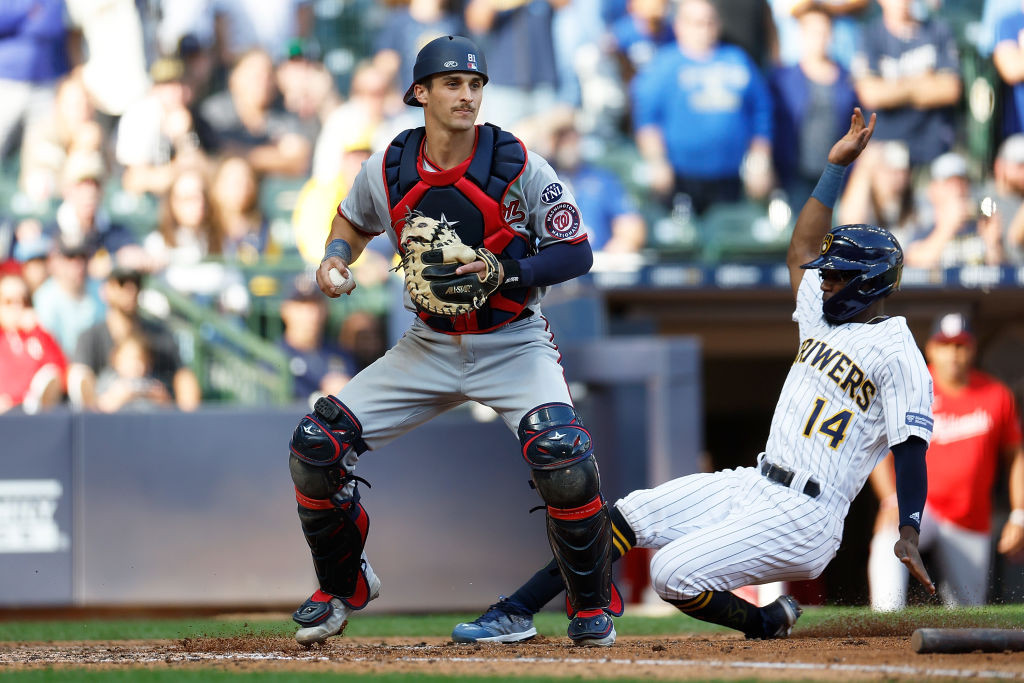WEST PALM BEACH, Fla. – It all happened so fast. Most everyone at Clover Park in Port St. Lucie probably didn’t even notice when Drew Millas tapped the top of his catcher’s mask after plate umpire Mark Stewart called a first-pitch curveball from Cole Henry to Jesus Baez low for ball one in the bottom of the second inning of Friday’s “Spring Breakout” prospects game between the Nationals and Mets.
Stewart, though, immediately let the crowd know what was happening, announcing over his microphone that Millas had challenged the call, which would now be reviewed by the Automated Balls and Strikes system.
And lo and behold, there on the scoreboard for everyone in the stadium to see, was a graphic showing the actual location of the pitch, which was indeed in the zone at the knees. Stewart announced the call was reversed, the count switched from 1-0 to 0-1 and play resumed.
The whole process took a handful of seconds from start to finish.
“I just saw the pitch was there,” Millas said, “and tapped my head.”
Welcome to the future of baseball. Actually, it’s already the current state of Triple-A baseball, where the ABS challenge system was used last season and where Millas got very comfortable with the process. It’s not officially major league-ready yet, but the trial run of the system during this week’s Spring Breakout games across the sport is giving everyone a preview of what’s likely to come in the not-too-distant future.
“It was awesome,” said Henry, who used that reversed call to propel him toward an eventual strikeout of Baez. “I’m always for a little challenge, and getting it right is awesome. If we can just keep doing that, we’ll be happy.”
There would be four total challenges during Friday’s game. Millas did it again in the bottom of the third and again successfully had a pitch originally called a ball reversed to a strike – this one a strike-three call to help out right-hander Travis Sykora.
“I heard about it, and I wasn’t a big fan of it,” said Sykora, just drafted out of high school last summer and making his first career professional appearance. “’Cause if you paint one a little off the edge and they call it a strike, they’re going to challenge it, and you’re not going to get the pitch. But today it actually worked in my favor. So I guess I’ve got to say I’m a fan of it now.”
Mets catcher Kevin Parada and Nationals backup catcher Max Romero each made an unsuccessful challenge, so for the game two calls were overturned and two calls were upheld.
In each instance, the disruption to the game flow was minimal. And fans seemed to get a kick out of the instant result on the scoreboard.
“I love that part of it,” Millas said. “In Triple-A, we had a lot of instances in Buffalo or Rochester where the challenge system would really get the fans going in a slow game. That aspect is good. And I don’t think it takes that long.”
This is different from a full-fledged, ABS system that essentially eliminates the plate umpire’s ball-strike responsibilities. Under that system, every pitch is called by the system, with each call immediately relayed through an earpiece to the umpire, who signals ball or strike.
The challenge system is something of a compromise. Each team is allowed to challenge only three calls during the course of a game. As in the National Football League, if a challenge is unsuccessful, the team loses that challenge. If it is successful, it gets to keep that one to use again.
So there is some strategy involved. You don’t want to waste a challenge on a borderline call in the top of the second if it prevents you from challenging a potential game-changing call in the bottom of the ninth.
Based on what Triple-A players and managers experienced last year, there’s another unwritten rule that is gaining steam: Only catchers should challenge calls, not pitchers.
“The thing they’ve told me is don’t ever let the pitchers challenge, because they’re 0-for-1,000,” Nats manager Davey Martinez said. “The catchers are really good at it.”
Millas doesn’t know what his success rate was last season, but he does believe he’s pretty good at it. He noted it’s usually best to challenge breaking balls at the bottom of the zone and fastballs on the outer edges, based on the way each type of pitch moves (and often deceives the eye).
Based on his 2-for-2 performance Friday, he seems to know what he’s talking about.
Traditionalists may continue to question just how effective the system is, or worry it will bog down a game that has made dramatic efforts to speed up the pace of play in recent years. Some umpires seem to appreciate the assistance. Others don’t like being shown up in front of an entire stadium.
For now, ABS remains a Triple-A experiment. For those who experienced it for the first time this week, though, it’s starting to feel inevitable at the major league level.
“I’ve seen it before,” Martinez said, “but to see it live like that, and to see it come up on the big screen like that, that’s pretty interesting.”
By accepting you will be accessing a service provided by a third-party external to https://www.masnsports.com/





